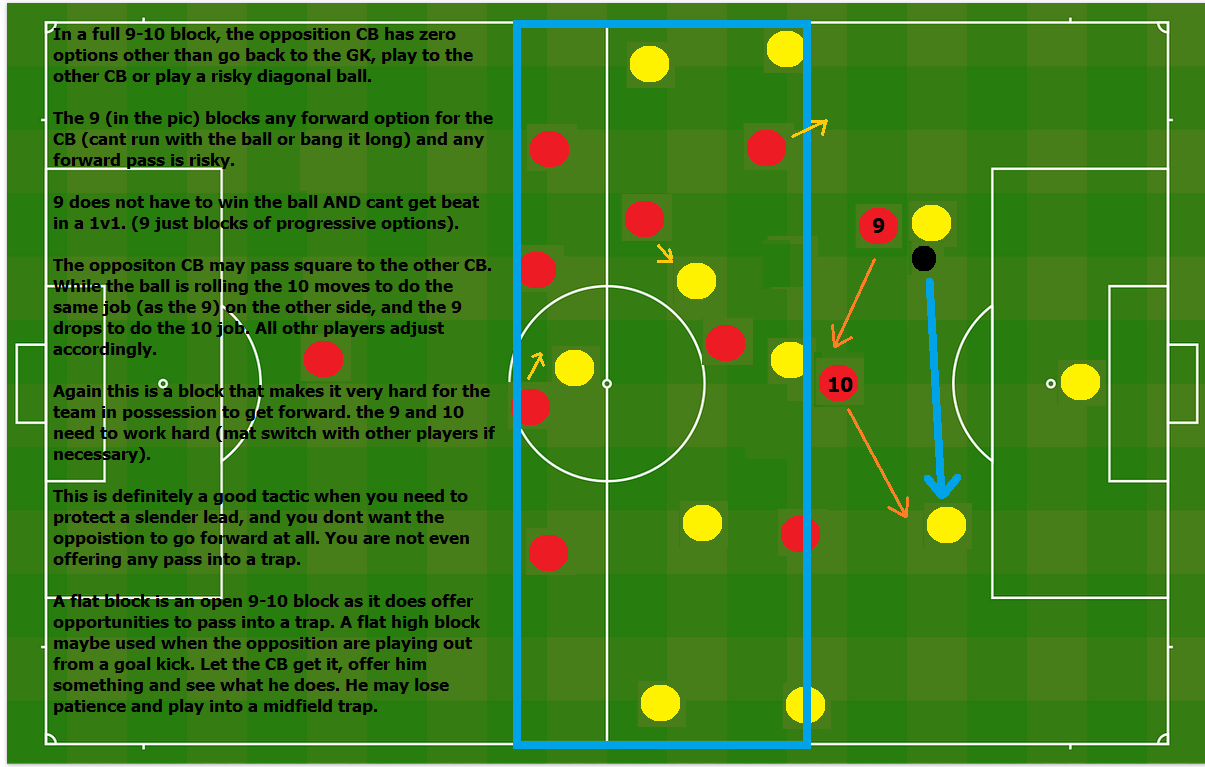9-10 Mid Block
A '#9-#10 Mid Block' is similar to the 'Flat mid Block'.
- It is set up in the middle of the pitch, and when the ball is played forward into the midfield space there is an aggressive press (this is the trap).
- The defensive line and goal keeper are also very switched on to the ball over the top.
The main difference with a #9-#10 press (compared to a 'Flat Mid block' is:
- The Objective of the block.
- In a 'flat mid block' the OCB (opposition Center back) is allowed the option to play forward, where as in the #9-10 mid block, this option is taken away.
- The Work the #9 & #10 have to do.
- The 9 & 10 have to work hard to fully limit the options for the OCBs.
Take a look at the pic below which hopefully highlights the following :
- The movement of the #9 and #10 prevents the OCBs from being able to play the ball forward easily.
- The block forces sideways and backwards passes and make forward passes more difficult.

If the picture above was in words......
Move while the ball is rolling.
- While the ball is rolling to, but before, the opposition center back (OCB) receives the ball, the 9 moves to a higher position that stops the OCB from playing forward (in any way). [ Note : The 9 cannot get beat in a 1v1 moment so cannot over commit to winning the ball].
- While the 9 is occupying the OCB, the 10 is in the oppositions '6' (O#6) space and stopping the OCB playing to into this space and stopping the O#6 being a way out.
Force sideways and backwards play.
- The #9 and #10 must make the OCB play sideways to the other OCB.
The #9 and #10 switch roles constantly.
- When the OCB passes to the other OCB, the #9 and #10 switch roles.
- [This switch needs to occur quickly, while the ball is rolling, so the OCB now on the ball doesn't have any easy forward options.]
The #9 & #10 must work really hard.
- The #9 & #10 need to work hard to make this work ( so may only be done towards the end of a match whilst trying to protect a lead).
- Maybe the wingers [or #6/#8] can swap roles to share the work if necessary.
Game Management.
- If you are winning the game and trying to see the game out, this is maybe a good block to use, especially against a good team.
It is not unbreakable.
- It is not an unbreakable block. Clever positioning and movement form OCB's and O#6 can break this block.
If it fails :
- As always, if the block / trap breaks down, then Drop & Block to a lower position.
Atletico Madrid Secrets To Defensive Perfection
The video below is a very general (but good) 'defending' video and looks at all aspects of defending.
In the video there are few different types of 'blocks' .
Task.
The examples you need to find are :
- Was a #9-#10 Mid block used?
- If, so what did it achieve?
- If not, what blocks were used?
The set up.
- Atletico can be seen to set up a 1-5-4 mid block which switches to other shapes (1-2-4-3 for example) when the moment requires.
- This differs from a 9/10 block ( in a 4-3-3 set up).
- Perhaps they set up like this because the opposition played with 3 at the back, and having that 1 higher player, forced the OCBs to always play diagonally backwards, and so in turn slowed down the ball transfer from one side of the pitch to the other, making it easier for Atletico to cover the full width of the pitch.
The 4-5-1 mid block is looked at later, but can be seen in this video.
This is the you tube link for this video : https://youtu.be/HMgum-rKb5U : Please watch the original and subscribe to the channel if you rate the video.